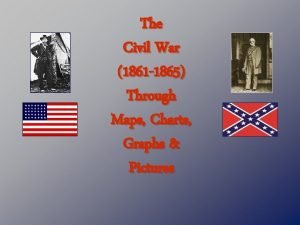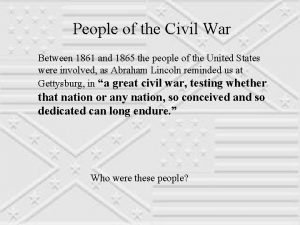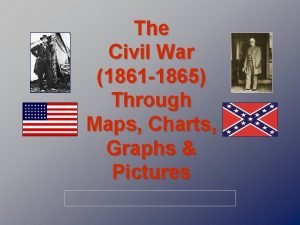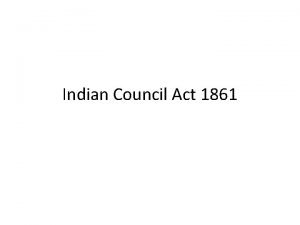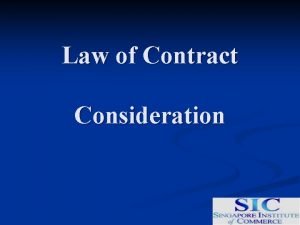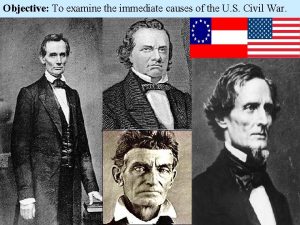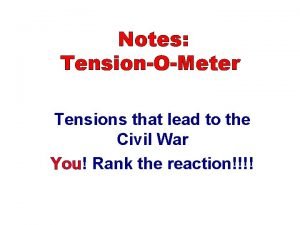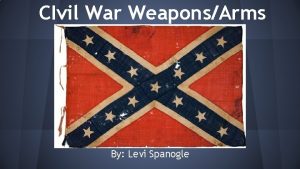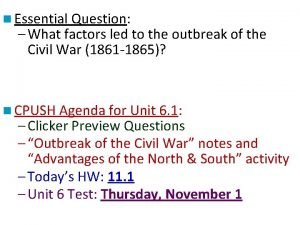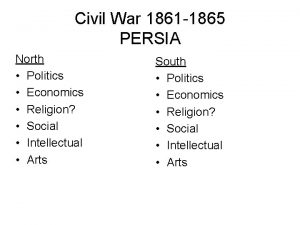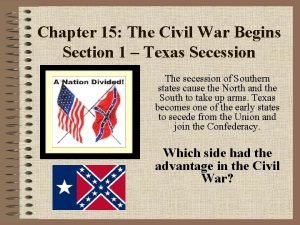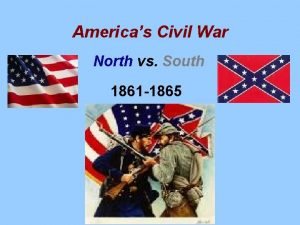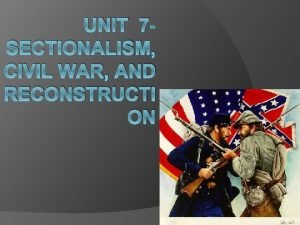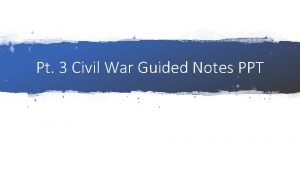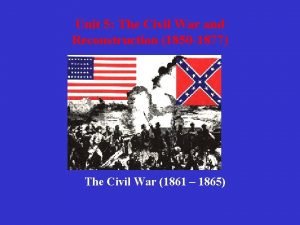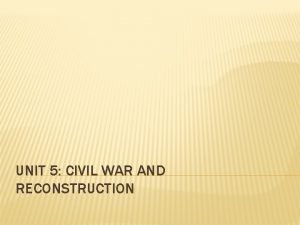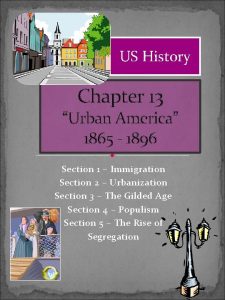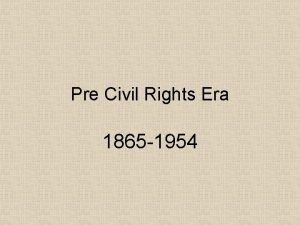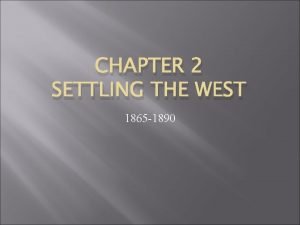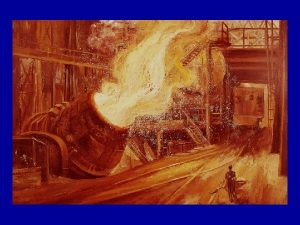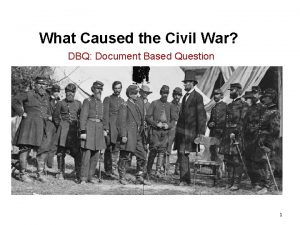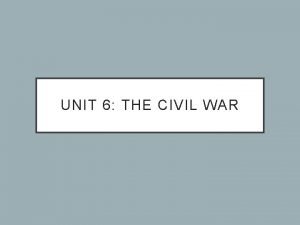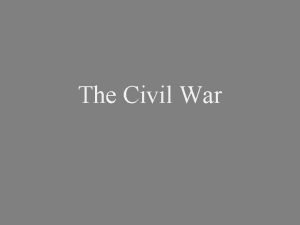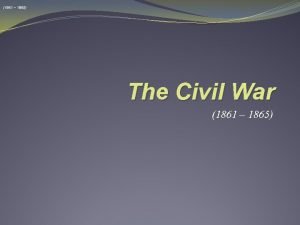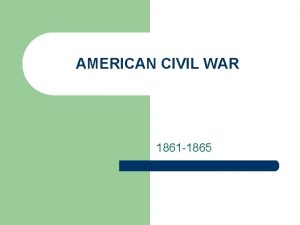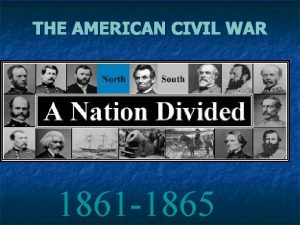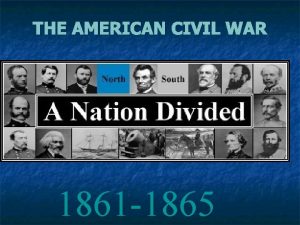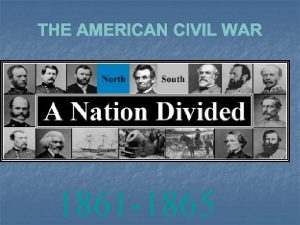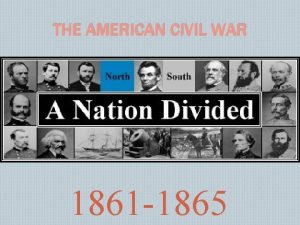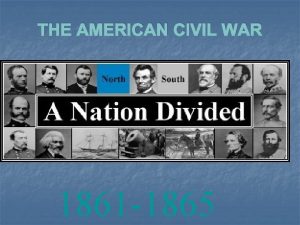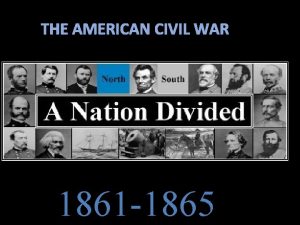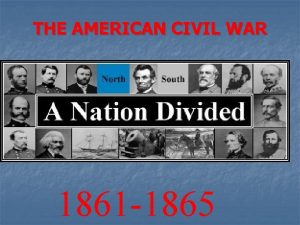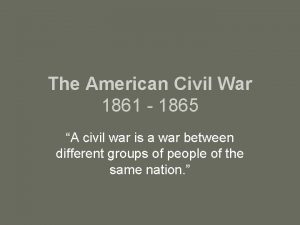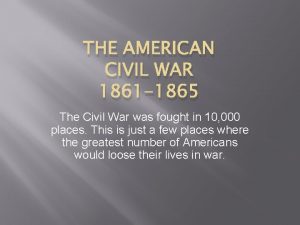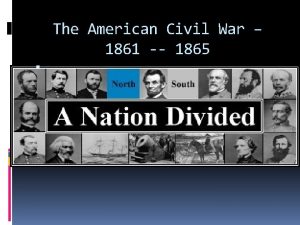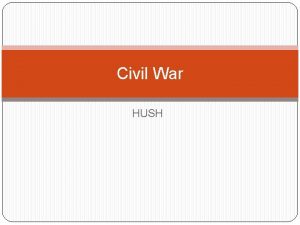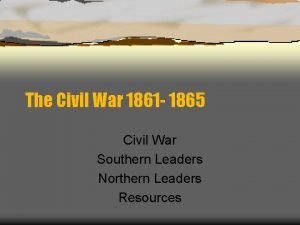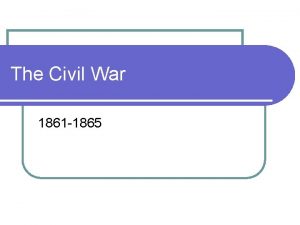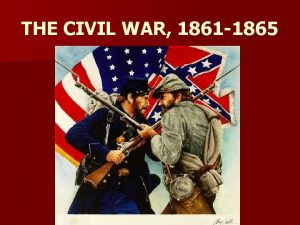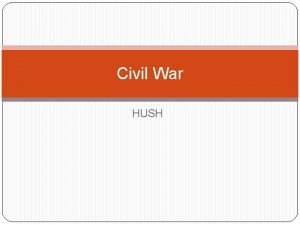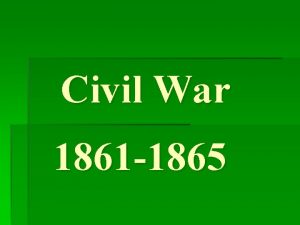American Civil War 1861 1865 Themes Compare and














































- Slides: 46

American Civil War (1861 – 1865)

Themes • Compare and contrast North and South • Highlight some of the important battles of the Civil War and life for soldiers

President Lincoln • Seven states had seceded; many thought he could not handle the situation that was presented to him • Lincoln: Morally opposed to slavery and did not support its spread but would not interfere where it was legal • Affirmed authority over all U. S. territory in states that had seceded from the Union • Result: Conflict

Fort Sumter (April 1861) • Fort Sumter, South Carolina, was low on supplies • Lincoln informed South Carolina’s Governor he was sending food and supplies in an unarmed ship • Confederate soldiers attacked the fort • Lincoln request 75, 000 volunteers to suppress the rebellion • No casualties; however war had begun • After battle four more states seceded: - Virginia, North Carolina, Tennessee, and Arkansas

Secession (1861)

Responses to Secession • Some in Virginia were opposed towards the idea of secession • People from western counties in Virginia chose a new governor and applied for statehood in the Union • Debate also was strong in Tennessee • Both states would eventually join the Confederacy

Confederate States of America (1861 -1865) • States: South Carolina, Mississippi, Florida, Alabama, Georgia, Louisiana, Texas, Virginia, North Carolina, Tennessee, and Arkansas • Constitution: States’ rights and protection of slavery in new territories • President: Jefferson Davis (Sen. of Mississippi & former Secretary of War 53 -57) • Capital: Richmond, VA

Border States • Border States – Slave states that remained loyal to the Union • Included: Delaware, Maryland, Kentucky, Missouri, and West Virginia

Secession (1861)

Lincoln and Border States • Following confrontation in Baltimore, the area became occupied by soldiers • Lincoln suspended writ of habeas corpus - Confederates could be jailed without charges indefinitely

Northern Advantages Population: North: 23 states and 22 million South: 11 states 9 million (5. 5 million whites) Industrial Production and Transportation: North: 90% of industrial capacity and 71% of railroad mileage - South: 10% of industrial capacity and 29% of railroad mileage Ex. 97% nation’s potential capacity for firearms • Farm Acreage: - North: 75% of nation’s farms - South: 25% of nation’s farms • • -

Union Strategies • Initial Strategy: Anaconda Plan - Blockade of Southern ports - Major campaign to control Mississippi River in order to cut Confederacy in half *Plan seemed great but Lincoln did not have the man power to see it through*

Southern Advantages • “Home Court Advantage” - Most fighting took place in the South • Concrete War Aims - South fought to preserve their way of life Southern life a little over 3 centuries old - North fought to preserve the Union • Officers - Many of the best officers fought with the Confederacy • King Cotton

King Cotton • Years before the Civil War, Southern cotton was traded to majority of European nations - 75% of all raw cotton in Great Britain’s factories came from South • Since 1800, cotton in the South will double almost every 10 years • Southerners gambled the British would intervene • Why did “King Cotton” fail? - British factories had surpluses of raw cotton - Cotton was imported from Egypt and India - Emancipation Proclamation: war to free slaves

Early War 1861 -62 • Many leaders thought the war could be short • Battle of Bull Run (June 1861) - Union forces led by Gen. Mc. Dowell against Confederated led by Gen. Beauregard • Many people looked upon the battle at a distance • Union forces were initially successful • However, Confederate reinforcements (Stonewall Jackson) arrived and routed Union troops

1 st Battle of Bull Run (Impact) • Union troops were determined never again to be humiliated in battle • Boosted confidence of Confederate forces • South now believed the war would be over very shortly

Early War 1861 -62 • Lincoln replaced Mc. Dowell with Mc. Clellan who created Army of the Potomac • Transformed unorganized troops into disciplined army • Remained cautious during fighting in the East

Shiloh (April 1862) • War in the west • Union forces were led by Ulysses S. Grant • planned an attack on a railroad near the border of Tennessee • However, Confederates staged a surprise attack on Grant

Shiloh

Shiloh • Initially Confederate forces were successful and began to push the Union back • Once reinforcements arrived, the Union will then take over the battle field • Casualties: over 23, 000 soldiers

Antietam/Sharpsburg

Antietam/Sharpsburg • Confederates led by Robert E. Lee invaded Maryland - Supplies were needed - Hoped to have their “Saratoga” • If Confederates win the battle, they might receive recognition and foreign aid from European nations

Antietam/Sharpsburg • Tactically a draw’; strategically a Union victory as the invasion was halted • Bloodiest single-day of fighting in the war • (24, 000 casualties)

Antietam/Sharpsburg (Impact) • Antietam- diplomatic victory • Lincoln reconsidered his views of the war and slavery - Was against slavery but did not support abolition • Drafted a proclamation to free slaves, but waited for a Union victory

Emancipation Proclamation • Five days after the Battle of Antietam • Freed slaves residing in states in rebellion against the Union • Did not free slaves in states loyal to the Union • January 1, 1863 • Lincoln maintained support of border states, yet it pushed them closer to emancipation • Transform war aims: - Union soldiers now fought to free slaves

Enrollment Act (1863) • Men 20 -45 were eligible for draft • Draftee could hire a Substitute to serve in his place • Draftee could also pay $300 to avoid service *Rich man’s war, poor man’s fight

Draft Riots: New York City (July 1863) • Working-class white men rioted and targeted: - Well-dressed white men, African Americans, and supporters of war • Several were injured; at least six blacks were lynched

Confederate Draft (1862) • Similar to North’s “Enrollment Act” • Twenty Negro Law: - Provided exemption for owners of 20 or more slaves - Created resentment among Southerners

Draft results • • - Draftees: Union 48, 000 Confederate 120, 000 Total size Union 2, 100, 000 Confederate 800, 000

African Soldiers • African Americans enlisted in Union Army after 1862 • Over 180, 000 served • Fought in segregated units and lower pay

Civil War Soldiers • Camp life was boring, but diseases could be deadly • Food for Union troops: - Beans, salted pork, pickled beef, hard-tack • Clothes were often supplied by the U. S. Sanitary Commission - Huge civilian organization that coordinated the efforts of thousands of women’s groups to buy and distribute clothing, food and medicine • Food for Confederate troops: - Bacon and cornmeal • Food and clothing were often short in supply • Brutality of combat transformed Union and Confederate soldiers

Civil War Soldiers • Medical care often involved amputations • Possibly 30% of amputees died following surgery due to infection

Civil War Soldiers • Prisoner of War Camps often had poor conditions • Andersonville held over 30, 000 - Designed for 10, 000 - About 14, 000 Union POWs died

War Continues (1863 -65) • Victory began to seem dim for the North • Confederates defeated Union troops at Chancellorsville May 1863 - Lee however will lose “Stonewall” Jackson • Union forces were unable to capture Vicksburg • Lee proposed an invasion of the North in 1863

Battle of Gettysburg (July 1863) • Confederate forces (now in the North territory) engaged with Union troops (led by Gen. Meade) at a small town in Pennsylvania • Battle took place over 3 days • Union troops defended Cemetery Ridge • Pickett attacked Union center July 3 rd • “Pickett’s charge” a huge defeat for the Confederates

Battle of Gettysburg (July 1863) • Gettysburg was bloodiest engagement of the war - Over 50, 000 Union and Confederate casualties • Robert E. Lee lost half his army

Vicksburg (May – July 1863) • Vicksburg fell to Union troops following a 2 month siege • Soon after Union forces controlled the Mississippi • The “tide turned” in favor of the Union

War Continues (1863 -65) • Robert E. Lee vs. Ulysses S. Grant • Both veterans of Mexican War • Lee was given position of Gen of Union Army but he succeeded • Battles at: The Wilderness, Spotsylvania Court House, Cold Harbor, Petersburg, Five Forks • ALL loses for Lee

Atlanta (September 1864) • • Atlanta fell to Union troops led by Sherman Atlanta was the industrial capital of the South Helped Lincoln win re-election Prior to election Lincoln was criticized by Democratic candidate Mc. Clellan and radicals in his own Republican Party during the election

Sherman’s March • Once Sherman took Atlanta his troops marched towards Savannah then to Raleigh • Everywhere Sherman went he burnt down crops, towns, and homes • “Scorched Earth” - Break the South’s will to fight

Appomattox (April 1865) • Lee vs. Grant • Lee retreated from Petersburg; low on men and supplies • Lee surrendered at Appomattox Courthouse April 9, 1865 • Terms of surrender - Confederates could return home - Within weeks other Confederate forces had surrendered

Battle of Palmito Ranch (May 13, 1865) • Location: Palmito Ranch near Brownsville, Texas • Union: most forces had already pulled out of south Texas • Confederates: stationed in Brownsville to protect their supply lines • Mexicans: sided with the Confederates • Battle is recorded as a Confederate victory

Death of a President (April 1865) • April 14, 1865 while attending a play, Lincoln was shot by John Wilkes Booth • Lincoln died the next day

Results of the Civil War (1861 -1865) 1. Slavery ended – how is the government going to address the status of over 4 million blacks 2. More than 600, 000 Americans died - more than WWII, WWI, Vietnam, Korean, Mexican, Revolutionary, 1812 combined 3. Much of the South was destroyed- how would it be rebuilt

Andrew Johnson • Johnson will now take over presidential duties after the death of Abraham Lincoln • Being a southern Democrat, Johnson is going to have a difficult time with Radical Republicans throughout the Reconstruction Era

• Advantaged of North and South on eve of war • Outlined key battles of the war
 Civil war 1861/1862
Civil war 1861/1862 Civil war 1861/1862
Civil war 1861/1862 Toward civil war lesson 3 secession and war
Toward civil war lesson 3 secession and war Realism naturalism and regionalism
Realism naturalism and regionalism Why was the civil war the first modern war
Why was the civil war the first modern war American civil war battles map
American civil war battles map Indian councils act 1861
Indian councils act 1861 Unionistička stranka 1861
Unionistička stranka 1861 Currie v misa
Currie v misa South carolina 1861
South carolina 1861 South carolina 1861
South carolina 1861 Springfield model 1861 rifle facts
Springfield model 1861 rifle facts Civil rights webquest
Civil rights webquest Civil war advantages and disadvantages chart
Civil war advantages and disadvantages chart Unit 4: civil war and reconstruction
Unit 4: civil war and reconstruction Civil war and reconstruction study guide
Civil war and reconstruction study guide Civil war advantages and disadvantages chart
Civil war advantages and disadvantages chart Civil war advantages and disadvantages chart
Civil war advantages and disadvantages chart North and south states civil war
North and south states civil war North and south states civil war
North and south states civil war Chapter 6 civil war and reconstruction
Chapter 6 civil war and reconstruction Civil war and reconstruction achieve 3000 answer key
Civil war and reconstruction achieve 3000 answer key Civil war ppt and guided notes
Civil war ppt and guided notes Unit 5 civil war and reconstruction
Unit 5 civil war and reconstruction Civil war and reconstruction vocabulary
Civil war and reconstruction vocabulary Guernica picasso
Guernica picasso Urban america 1865 to 1896
Urban america 1865 to 1896 St helen’s smelting co v tipping (1865)
St helen’s smelting co v tipping (1865) The rise of industrial america 1865-1900
The rise of industrial america 1865-1900 The rise of industrial america 1865-1900
The rise of industrial america 1865-1900 15 th ammendment
15 th ammendment Industrialization (1865 to 1901 worksheet answers key)
Industrialization (1865 to 1901 worksheet answers key) Becoming a world power 1865-1917
Becoming a world power 1865-1917 Impressionism characteristics
Impressionism characteristics Becoming a world power 1865-1917
Becoming a world power 1865-1917 Native clothing
Native clothing Gregor mendel 1865
Gregor mendel 1865 Where did the term “impressionism” come from?
Where did the term “impressionism” come from? Whats the compromise of 1877
Whats the compromise of 1877 Industrialization (1865 to 1901 worksheet answers key)
Industrialization (1865 to 1901 worksheet answers key) 1865 to 1900 inventions
1865 to 1900 inventions What caused the civil war dbq
What caused the civil war dbq Map of fort sumter
Map of fort sumter Causes of civil war
Causes of civil war Gettysburg battle
Gettysburg battle Timeline of the english civil war
Timeline of the english civil war What led to civil war
What led to civil war
